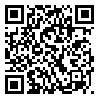Volume 2, Issue 5 (2004)
LIRE 2004, 2(5): 7-38 |
Back to browse issues page
Download citation:
BibTeX | RIS | EndNote | Medlars | ProCite | Reference Manager | RefWorks
Send citation to:



BibTeX | RIS | EndNote | Medlars | ProCite | Reference Manager | RefWorks
Send citation to:
Verb ending and its writing style in Farsi letters
Ahmad Tamimdari , Atoma Forouhi. LIRE 2004; 2 (5) :7-38
URL: http://lire.modares.ac.ir/article-41-4324-en.html
URL: http://lire.modares.ac.ir/article-41-4324-en.html
Abstract: (5349 Views)
Although more than thousand years has passed from written literature of Persian language, paying attention to the unity of writing and editing is a new topic.
This new event is because of growing public education and increasing number of printed books. Anisotropy of spelling is the result of not paying attention to establishing the grammar of Persian language. One of the important reasons for such anisotropy is the fact the user of any language acquire the rules of the language when learning their mother language. Therefore just like the social rules and regulations control the social evolutions and coordination and adopting the affairs and prevention of social chaos, the grammar sets up the linguistic relations and observing the norms and also prevents any disorders in the language with due regard to the evolutions and their developments based on the new requirements in the form of approved rules and regulations.
Entry or the subjective attached pronoun is on of the important points in Persian grammar to which less attention has been paid grammatically specially in the area of writing styles. So, in this short opportunity we try, study briefly the history of Persian grammar and spelling and its role in the Persian language aimed at reaching a unified approach and the various views in this regard have been analyzed thought a look at its background.
This new event is because of growing public education and increasing number of printed books. Anisotropy of spelling is the result of not paying attention to establishing the grammar of Persian language. One of the important reasons for such anisotropy is the fact the user of any language acquire the rules of the language when learning their mother language. Therefore just like the social rules and regulations control the social evolutions and coordination and adopting the affairs and prevention of social chaos, the grammar sets up the linguistic relations and observing the norms and also prevents any disorders in the language with due regard to the evolutions and their developments based on the new requirements in the form of approved rules and regulations.
Entry or the subjective attached pronoun is on of the important points in Persian grammar to which less attention has been paid grammatically specially in the area of writing styles. So, in this short opportunity we try, study briefly the history of Persian grammar and spelling and its role in the Persian language aimed at reaching a unified approach and the various views in this regard have been analyzed thought a look at its background.
Keywords: entry, subjective attached pronouns, Persian spelling, Persian grammar, and Persian language.
Subject:
Farsi language
Received: 2004/07/17 | Accepted: 2004/12/12 | Published: 2004/12/20
Received: 2004/07/17 | Accepted: 2004/12/12 | Published: 2004/12/20
| Rights and permissions | |
 |
This work is licensed under a Creative Commons Attribution-NonCommercial 4.0 International License. |







